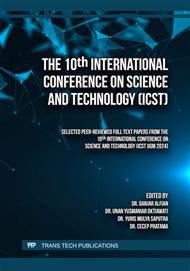p.185
p.192
p.202
p.214
p.225
p.238
p.249
p.256
p.273
The Vibration Analysis on Various Railway Damages Using Support Vector Machine Method
Abstract:
The frequent use of railway tracks in railway operations can cause damage or wear that can disrupt comfort and resulted vibrations on the trains. There are various types of damage that can occur to railway tracks, one of which is longitudinal level damage. Machine learning can be employed to predict the damage. However, it is quite difficult to predict based on real data with a high amount of data. Therefore, a railway miniature is fabricated with a controlled damage. Therefore, this study has purpose to predict the damage using the produced data from railway miniature. The vibrations was measured using an accelerometer device that available on smartphones with the Phypox application, and it will be mounted on a miniature railway track with three different track conditions: one normal and two abnormal, with each track condition has 50 data points. With the assistance of machine learning as the main brain behind the vibration detection program, vibration data can be classified based on the track conditions experienced. The data was processed into frequency domain using Fast Fourier Transform (FFT) algorithm, filtered using SG-Filter, and Power Spectral Density (PSD) will be used to assess the strength of the vibration signal. The vibration data processing was carried out using Jupyter Notebook software with Python programming language. Classification was performed by applying supervised machine learning using the classification method of Support Vector Machine (SVM). In classification process, results obtained show an accuracy of 88.19% for training model and an accuracy of 82.61% for testing model, computed using 85% of total data for training model and 15% of total data for testing model. The produced data and built machine learning can be further applied for checking the rail damage at uncontrollable environment.
Info:
Periodical:
Pages:
225-237
Citation:
Online since:
October 2025
Keywords:
Price:
Сopyright:
© 2025 Trans Tech Publications Ltd. All Rights Reserved
Share:
Citation:


